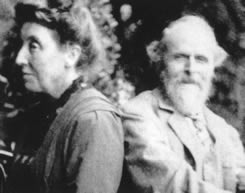|
Night And Sleep
''Night and Sleep'' is an 1878 painting by Evelyn De Morgan, an English painter whose works were influenced by the style of the Pre-Raphaelite movement. In the painting dark-haired Night guides her son Sleep. His relaxed pose is set against the "more energetic line of his mother's body." Art historian Elise Lawton Smith notes that the couple's "horizontality suggests both sleep and lateral movement as they pass across the landscape". Poppy, Poppies, symbolic of sleep, peace, death and the artist's pacifism, are listlessly strewn by the somnolent Sleep as he passes. References 1878 paintings Paintings by Evelyn De Morgan {{Art-stub ... [...More Info...] [...Related Items...] OR: [Wikipedia] [Google] [Baidu] |
Evelyn De Morgan
Evelyn De Morgan (30 August 1855 – 2 May 1919), née Pickering, was an English painter associated early in her career with the later phase of the Pre-Raphaelite Movement, and working in a range of styles including Aestheticism and Symbolism. Her paintings are figural, foregrounding the female body through the use of spiritual, mythological, and allegorical themes. They rely on a range of metaphors (such as light and darkness, transformation, and bondage) to express what several scholars have identified as spiritualist and feminist content. De Morgan boycotted the Royal Academy and signed the Declaration in Favour of Women's Suffrage in 1889. Her later works also deal with the themes of war from a pacifist perspective, engaging with conflicts like the Second Boer War and World War I. Early life She was born Mary Evelyn Pickering at 6 Grosvenor Street, to Percival Pickering QC, the Recorder of Pontefract, and Anna Maria Wilhelmina Spencer Stanhope, the sister of the art ... [...More Info...] [...Related Items...] OR: [Wikipedia] [Google] [Baidu] |
Oil Painting
Oil painting is the process of painting with pigments with a medium of drying oil as the binder. It has been the most common technique for artistic painting on wood panel or canvas for several centuries, spreading from Europe to the rest of the world. The advantages of oil for painting images include "greater flexibility, richer and denser colour, the use of layers, and a wider range from light to dark". But the process is slower, especially when one layer of paint needs to be allowed to dry before another is applied. The oldest known oil paintings were created by Buddhist artists in Afghanistan and date back to the 7th century AD. The technique of binding pigments in oil was later brought to Europe in the 15th century, about 900 years later. The adoption of oil paint by Europeans began with Early Netherlandish painting in Northern Europe, and by the height of the Renaissance, oil painting techniques had almost completely replaced the use of tempera paints in the majority ... [...More Info...] [...Related Items...] OR: [Wikipedia] [Google] [Baidu] |
Canvas
Canvas is an extremely durable plain-woven fabric used for making sails, tents, marquees, backpacks, shelters, as a support for oil painting and for other items for which sturdiness is required, as well as in such fashion objects as handbags, electronic device cases, and shoes. It is popularly used by artists as a painting surface, typically stretched across a wooden frame. Modern canvas is usually made of cotton or linen, or sometimes polyvinyl chloride (PVC), although historically it was made from hemp. It differs from other heavy cotton fabrics, such as denim, in being plain weave rather than twill weave. Canvas comes in two basic types: plain and duck. The threads in duck canvas are more tightly woven. The term ''duck'' comes from the Dutch word for cloth, ''doek''. In the United States, canvas is classified in two ways: by weight (ounces per square yard) and by a graded number system. The numbers run in reverse of the weight so a number 10 canvas is lighter than number ... [...More Info...] [...Related Items...] OR: [Wikipedia] [Google] [Baidu] |
Wightwick Manor
The legacy of a family's passion for Victorian art and design, Wightwick Manor (pronounced "Wittick") is a Victorian manor house located on Wightwick Bank, Wolverhampton, West Midlands, England. Owned by the National Trust since 1937, the Manor and its grounds are open to the public. It is one of only a few surviving examples of a house built and furnished under the influence of the Aesthetic movement and Arts and Crafts movement. The house is in a grand version of the half-timbered vernacular style, of which the most famous original example is Little Moreton Hall over 40 miles to the north, in Cheshire (also National Trust). The house is a notable example of the influence of William Morris, with original Morris wallpapers and fabrics, De Morgan tiles, Kempe glass and Pre-Raphaelite works of art, including works by Dante Gabriel Rossetti, Evelyn De Morgan, Edward Burne-Jones, Ford Madox Brown, John Everett Millais, Elizabeth Siddal and Leonard Shuffrey. History Wightwick w ... [...More Info...] [...Related Items...] OR: [Wikipedia] [Google] [Baidu] |
Pre-Raphaelite
The Pre-Raphaelite Brotherhood (later known as the Pre-Raphaelites) was a group of English painters, poets, and art critics, founded in 1848 by William Holman Hunt, John Everett Millais, Dante Gabriel Rossetti, William Michael Rossetti, James Collinson, Frederic George Stephens and Thomas Woolner who formed a seven-member "Brotherhood" modelled in part on the Nazarene movement. The Brotherhood was only ever a loose association and their principles were shared by other artists of the time, including Ford Madox Brown, Arthur Hughes and Marie Spartali Stillman. Later followers of the principles of the Brotherhood included Edward Burne-Jones, William Morris and John William Waterhouse. The group sought a return to the abundant detail, intense colours and complex compositions of Quattrocento Italian art. They rejected what they regarded as the mechanistic approach first adopted by Mannerist artists who succeeded Raphael and Michelangelo. The Brotherhood believed the Classical p ... [...More Info...] [...Related Items...] OR: [Wikipedia] [Google] [Baidu] |



.jpg)
